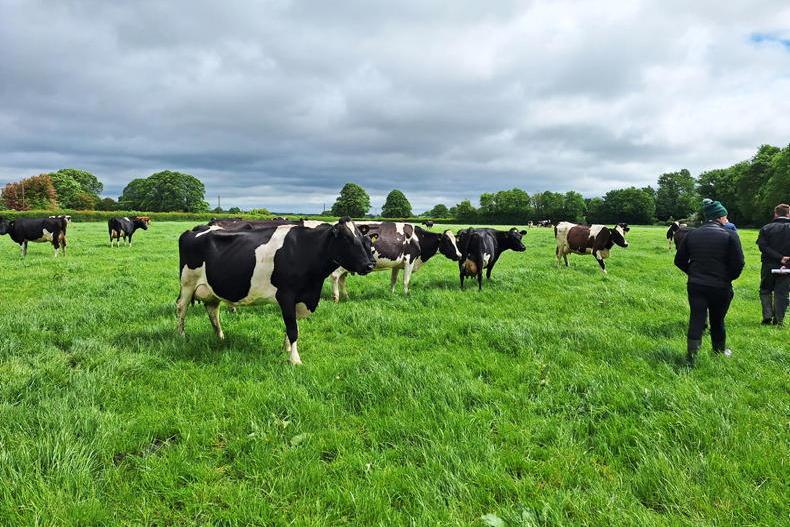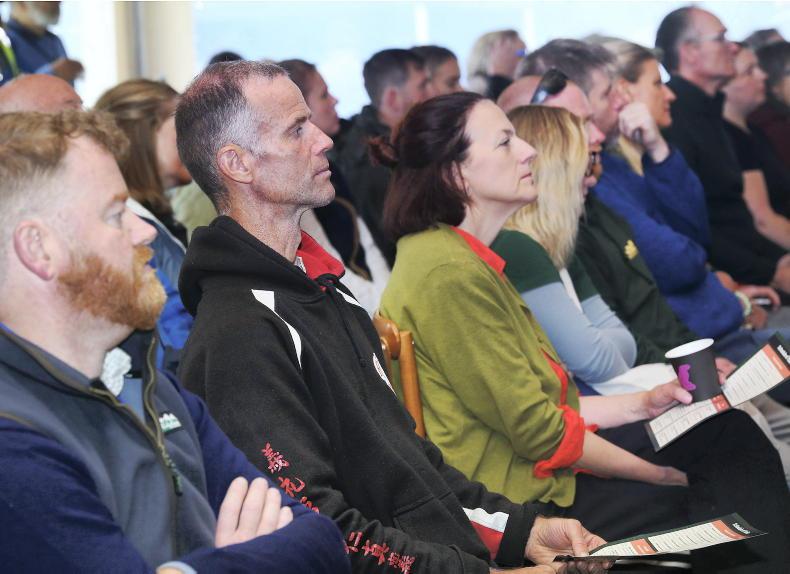Many dairy farmers who have been on track to meet their grazing targets are now facing sluggish regrowth in early-grazed paddocks. Fields grazed late in 2024, with current covers below 450kg DM/ha, are particularly slow to grow, if at all. However, reseeded paddocks from last year are showing the best regrowth.
With grass growth lagging, it is essential for farmers to assess their current grass supply and adjust their spring rotation planner accordingly. If growth rates do not improve soon, delaying the start of the second rotation may be necessary.
Failing to do so could lead to a severe grass shortage in early April – just as cows reach peak milk production – forcing farms to rely heavily on silage and meal.
You should pay particular attention to the grass cover on the first couple of paddocks grazed. The goal is to achieve 600kg DM/ha on these paddocks by St Patrick’s Day, setting the stage for reaching a total of 1,200kg DM/ha by the start of the second grazing rotation. For those planning to kick off the second round on 10 April, this means a daily growth rate of about 25kg DM/ha is essential to hit the target.
For farms with a cover below 750kg DM/ha, the priority should be limiting grazing to one grass allocation per day, with the remainder of the diet supplemented by silage and meal.
The goal should be to reduce daily grass demand to below 15kg DM/ha to match growth rate. As the saying goes, “grass grows grass”, so giving paddocks time to recover is crucial.
Farmers with access to silage ground for the milking herd should aim to have it grazed off by the end of March, if not already done.
Once grazed, these fields should be closed off for silage, targeting a mid-May cut.
Sward watch
Get out and walk the farm; calculate the percentage of the platform grazed and view it alongside your current growth rate.Stick to the spring rotation planner. Don’t be tempted to exceed targets, as a lack of grass in April is much more costly than buffering with silage now.Silage ground on the milking platform should be grazed soon for cutting mid-May.Danny Bermingham, Doonbeg, Co Clare
To date, 11% of the farm has been grazed since early last week. Cows are housed at night, receiving a diet of 72% silage. While some areas of the farm remain wet, current conditions are allowing drying. Farm cover has declined over the winter, with paddocks that were closed at 1,000kg DM/ha reopening at approximately 600kg DM/ha. Calving is progressing well, with nearly 90% of cows calved to date – an increase of almost 20% compared to the same week last year. Paddocks that received slurry and fertiliser early are noticeably greener. This week, 23 units of protected urea will be spread across the grazing platform to support regrowth.
Stocking Rate (cow/ha) :2.5
Growth Rate (kg/day) :2
Average Farm Cover (kg/ha):478
Yield (l/cow):25
Fat%:4.87
Protein%:3.52
Milk Solids (kg/cow):2.16
Concentrates : 6
John Joe Collins, Ballyhaise, Teagasc,/ch>
This year, we pushed our calving start date back by 10 days to ensure sufficient grass availability for the second grazing rotation, avoiding the need for silage in the diet.
Cows have been out by day since 25 February and have been at grass full-time since 7 March.
So far, 9% of the farm has been grazed, with 50% of cows calved. Slurry was applied at a rate of 2,500 gallons per acre on 10% of the grazing platform on 11 February, followed by half a bag of protected urea per acre spread on 3 March.
Cows approaching calving are receiving half a kilo of soya, with minerals provided ad-lib.
Stocking Rate (cow/ha) :2.7
Growth Rate (kg/ha): 7
Average Farm Cover (kg/cow):900
Yield (l/cow) :22.4
Fat%: 5.20
Protein%:3.92
Milk Solids (kg/cow) 2.1
Concentrates:4
John Blackburn, Glanworth, Co Cork
Over 75% of the herd has now calved, with minimal health issues so far. Calving has gone smoothly overall. Cows are out by day and despite some paddocks remaining soft, grazing is well on track, with 42% grazed to date. At night cows are housed on silage and receive 18% concentrate in the parlour. The goal is to have them out full time by the end of the week, but a rise in temperatures will be needed to drive grass growth. Around 70% of the farm has received 30 units of 18-6-12 fertiliser, while the remaining 30% was spread with 3,000 gallons/ac of slurry. Over the coming week, all paddocks will be topped up to 55 units, to encourage strong regrowth.
Stocking Rate (cow/ha):2.47
Growth Rate (kg/ha):12
Average Farm Cover (kg/cow):765
Yield (l/cow):20.5
Fat%:4.61
Protein%:3.46
Milk Solids (kg/cow):1.7
Concentrates:5
Many dairy farmers who have been on track to meet their grazing targets are now facing sluggish regrowth in early-grazed paddocks. Fields grazed late in 2024, with current covers below 450kg DM/ha, are particularly slow to grow, if at all. However, reseeded paddocks from last year are showing the best regrowth.
With grass growth lagging, it is essential for farmers to assess their current grass supply and adjust their spring rotation planner accordingly. If growth rates do not improve soon, delaying the start of the second rotation may be necessary.
Failing to do so could lead to a severe grass shortage in early April – just as cows reach peak milk production – forcing farms to rely heavily on silage and meal.
You should pay particular attention to the grass cover on the first couple of paddocks grazed. The goal is to achieve 600kg DM/ha on these paddocks by St Patrick’s Day, setting the stage for reaching a total of 1,200kg DM/ha by the start of the second grazing rotation. For those planning to kick off the second round on 10 April, this means a daily growth rate of about 25kg DM/ha is essential to hit the target.
For farms with a cover below 750kg DM/ha, the priority should be limiting grazing to one grass allocation per day, with the remainder of the diet supplemented by silage and meal.
The goal should be to reduce daily grass demand to below 15kg DM/ha to match growth rate. As the saying goes, “grass grows grass”, so giving paddocks time to recover is crucial.
Farmers with access to silage ground for the milking herd should aim to have it grazed off by the end of March, if not already done.
Once grazed, these fields should be closed off for silage, targeting a mid-May cut.
Sward watch
Get out and walk the farm; calculate the percentage of the platform grazed and view it alongside your current growth rate.Stick to the spring rotation planner. Don’t be tempted to exceed targets, as a lack of grass in April is much more costly than buffering with silage now.Silage ground on the milking platform should be grazed soon for cutting mid-May.Danny Bermingham, Doonbeg, Co Clare
To date, 11% of the farm has been grazed since early last week. Cows are housed at night, receiving a diet of 72% silage. While some areas of the farm remain wet, current conditions are allowing drying. Farm cover has declined over the winter, with paddocks that were closed at 1,000kg DM/ha reopening at approximately 600kg DM/ha. Calving is progressing well, with nearly 90% of cows calved to date – an increase of almost 20% compared to the same week last year. Paddocks that received slurry and fertiliser early are noticeably greener. This week, 23 units of protected urea will be spread across the grazing platform to support regrowth.
Stocking Rate (cow/ha) :2.5
Growth Rate (kg/day) :2
Average Farm Cover (kg/ha):478
Yield (l/cow):25
Fat%:4.87
Protein%:3.52
Milk Solids (kg/cow):2.16
Concentrates : 6
John Joe Collins, Ballyhaise, Teagasc,/ch>
This year, we pushed our calving start date back by 10 days to ensure sufficient grass availability for the second grazing rotation, avoiding the need for silage in the diet.
Cows have been out by day since 25 February and have been at grass full-time since 7 March.
So far, 9% of the farm has been grazed, with 50% of cows calved. Slurry was applied at a rate of 2,500 gallons per acre on 10% of the grazing platform on 11 February, followed by half a bag of protected urea per acre spread on 3 March.
Cows approaching calving are receiving half a kilo of soya, with minerals provided ad-lib.
Stocking Rate (cow/ha) :2.7
Growth Rate (kg/ha): 7
Average Farm Cover (kg/cow):900
Yield (l/cow) :22.4
Fat%: 5.20
Protein%:3.92
Milk Solids (kg/cow) 2.1
Concentrates:4
John Blackburn, Glanworth, Co Cork
Over 75% of the herd has now calved, with minimal health issues so far. Calving has gone smoothly overall. Cows are out by day and despite some paddocks remaining soft, grazing is well on track, with 42% grazed to date. At night cows are housed on silage and receive 18% concentrate in the parlour. The goal is to have them out full time by the end of the week, but a rise in temperatures will be needed to drive grass growth. Around 70% of the farm has received 30 units of 18-6-12 fertiliser, while the remaining 30% was spread with 3,000 gallons/ac of slurry. Over the coming week, all paddocks will be topped up to 55 units, to encourage strong regrowth.
Stocking Rate (cow/ha):2.47
Growth Rate (kg/ha):12
Average Farm Cover (kg/cow):765
Yield (l/cow):20.5
Fat%:4.61
Protein%:3.46
Milk Solids (kg/cow):1.7
Concentrates:5










SHARING OPTIONS